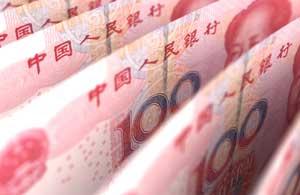China’s Efforts to Boost the Yuan

For some time now, China has been using traditional and novel policy tools to fight speculative pressure to devalue its currency. However, it remains to be seen if these efforts will be effective in the long run, according to a recent Economic Synopses essay.
China appears to be in the middle of a balancing act. Assistant Vice President and Economist Christopher Neely noted that China wants to maintain a stable exchange rate. However, it may need to raise interest rates to keep the yuan’s value from falling. He then noted: “But raising interest rates would further slow the economy when the Chinese economy is already slowing, albeit from a blistering pace of growth.”
China’s Monetary Policy
Indeed, foreign exchange traders seem to believe that China is reluctant to tighten monetary policy, Neely said. Based on options prices as of Sept. 26, 2016, the market indicated a 22 percent chance of a devaluation of at least 10 percent within one year.
Neely wrote: “This probability suggests that foreign exchange traders see a good chance of a significant devaluation of the Chinese currency but virtually no chance of a large, long-term revaluation.”
Shorting the Yuan
In hopes of profiting from this fall in the value of the yuan, Neely noted that speculators in Hong Kong have been trying to “short” the yuan. “Shorting a currency means borrowing it and selling it, hoping for the price to fall so that one can repay the loan in a devalued asset,” he wrote, adding that shorting a currency tends to decrease its price.
This speculative pressure to devalue the yuan has prompted Chinese authorities to fight back with traditional tools—such as imposing capital controls and practicing sterilized intervention—as well as some non-traditional tools.
Capital Controls
Neely explained that capital controls are taxes or restrictions on international transactions in assets like stocks or bonds. In China’s case, authorities restrict the amount of foreign currency their residents can purchase each year, which helps inhibit speculation against the yuan’s value.
Sterilized Intervention
Sterilized intervention means that a central bank buys or sells foreign currency without letting these transactions affect the domestic money supply or interest rates, Neely explained. Since June 2014, the People’s Bank of China (PBOC) has been purchasing its own currency on foreign exchange markets to keep the yuan from falling in value, he noted, adding that the PBOC has funded these purchases by selling some of its vast foreign exchange reserves.
“Ordinarily, such CNY purchases would reduce the domestic money supply, but the PBOC has simultaneously taken action to reverse the effect of the CNY purchases on domestic monetary conditions,” Neely noted.
Reducing Liquidity to Hong Kong Banks
While most yuan speculation occurs in the Hong Kong markets where China’s capital controls do not apply, these markets are not entirely out of reach of the Chinese authorities, Neely said.
He noted that in the first week of January 2017, the PBOC instructed its banks to reduce the liquidity provided to Hong Kong banks, “squeezing” investors who bet against the yuan.1 This caused the interbank overnight interest rate for yuan deposits in Hong Kong to rise substantially. Neely noted that this rate peaked at 61 percent on Jan. 6. (For a figure showing this rise, see the essay “The People’s Bank of China Boosts the Yuan.”)
“Such high interest rates made it very expensive to ‘short’ the CNY,” Neely said. “As a result of this liquidity squeeze, the CNY gained 1 percent in value from January 3 to January 5, 2017.”
Additional Factors
Two additional factors may have contributed to the PBOC’s recent decision to take action to boost the yuan, Neely explained.
“First, the CNY/USD has been approaching the psychologically important level of 7.0, which the Chinese authorities would like to maintain as an upper bound,” Neely said. “Second, the inauguration of Donald Trump as the U.S. president may put additional devaluation pressure on the CNY through its effects on expectations of U.S. trade policies.”
Notes and References
1 Cui, Carolyn; Vaishampayan, Saumya; and Wei, Lingling. “Yuan Reverses Course, Soars Against Dollar.” The Wall Street Journal, Jan. 5, 2017.
Additional Resources
- Economic Synopses: The People's Bank of China Boosts the Yuan
- On the Economy: The Exports of Innovative Countries
- On the Economy: How Tourism Affects China’s Current Account Surplus
This blog offers commentary, analysis and data from our economists and experts. Views expressed are not necessarily those of the St. Louis Fed or Federal Reserve System.
Email Us
All other blog-related questions

